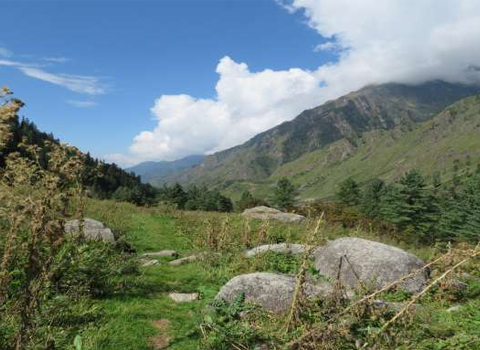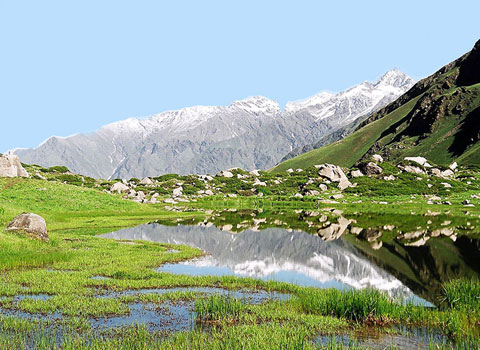Overview
Name Of Trek: Ruin Sara
Region: Uttarakhand
Duration: 7 Days
Level: Easy to Moderats
Distance: 55kms
Altitude: Max 3350m
Pickup Point: Dehradun(UK)
Drop Point: Dehradun
Best Season: Summers: April, May, June
Base Camp: Sankri
Brief ITINERARY
Day-1
Arrive at Dehradun Railway station
Pick up from Dehradun is between 6am to 7am
You are expected to reach Sankri by 5pm
Day-2
Drive from Sankri to Taluka(approx 12kms).Trek starts from Taluka
Trek to Puani Garat.Its 13kms/8hours trek
Day-3
Puani Garaat to Roiltia.Its 5kms/6hours trek
Day-4
Trek from Roiltia to Ruin Sara lake.Its 9kms/5-6hours trek
Day-5
Trek back from Ruin Sara to Puani Garaat .Its 14kms/6hours trek.
Day-6
Puani Garaat to Taluka to Sankri.13kms plus 12kms drive.Its 6-7hours approx
Day-7
Sankri to Dehradun 185 kms
DETAILED ITIERNARY
Day-1
Dehradun to Sankri
Altitude - 1980m.
Time taken - 10-11 hours
You will be greeted by the authorised person of company at Dehradun Railway station and by taxi you will move towads Sankri .The journey from Dehradun to Sankri takes aroun 10-11 hours .
After having dinner pack accordingly as you have to start the trekking early morning tomorrow.You will experience the first night out under the tents.
Day-2
Sankri to Taluka to Puani Garaat
Altitude - 1980m to 2524m .
Distance - 12kmsdrive plus 13kms trek.
Time taken - 8-9 hours
The day starts with drive to Taluka from where the actual trek starts.Drive from Sankri to Tauka is very exciting as well as adventourous.Taluka is a very small village with contrasting architecture which is 300years old.Start trekking towards Puani Garaat descending towards the river valley of Supin along the way you will cross the Sujangarh cemented bridge to reach Dhamtir village having magnificent views of lush greens meadows,vegitation,orchids etc etc.You will reach Puani Garaat between 5pm to 6pm enjoy hot freshly cokked snacks and healthy dinner before going to sleep in tents.
Day-3
Puani Garaat to Roiltia.
Altitude - 2900m
Distance - 5kms .
Time taken - 6hours.
Get ready for the 3rd day.Have your breakfast and walk towards Roiltia.You will walk along the rivertone and ascend through the fields and climb high above the confluence of the Ton and Ruinsara gad.
Before reaching Roiltia we will cross the meadows of Diusu Bugyal .Enjoy the surroundings whike exploring the place.We will serve you evening snacks.After the dinner spent night in the tents.
Day-4
Roiltia to Ruinsara taal
Altitude - 2900m to 3350m.
Distance - 9kms .
Time taken - 5-6hours.
After breakfast we start our day trekking towards Ruinsara lake which is a beautiful lake surrounded by meadows and Rhododendon bushes.Bandar-Poonch peak is at the east of the lake and if you walk toward the south east of the lake we can have a view of splendid Kiarkoti meadows and to the northest Swarg Rohini range.The lake is a clear water lake at the foot of Mount Kalang. The lake is surrounded by Alpine pastures.Located just below the Bandar Poonch glacier the lake is an ideal campside.
Day-5
Ruin sara taal to Puani Garaat.
Altitude - 2524m t0 19800m .
Distance - 13kms plus 12kms drive.
Time taken - 6-7hours.
Trek back to Taluka and drive back to Sankri
Day-6
Sankri to Dehradun
Conratulations you have completed the trek. Drive back to Dehradun.
You will be moving about 4000mts so be prepared for some Altitude sickness but our team will acclimatize you in two stages . One at your camp and also at 1500mts above Today you will learn some trekking techniques in the snow like side stepping,kicking and plunging the snow,way to slide on the snow etc. After a kilometre walk to Dhanderas Thatch base you will arrive at snow patch of waterfall .Please follow your trek leader instyuctions carefully and strictly After crossing the big boulder you will be ice axe to cut through the snow patches,this will continue until you arrive at big snow bridge,where you witness water fall down and disappearing below the bridge Continue to trek to the other side of Rupin and reach next camp alongside the upper waterfall.
Day-7
Upperfall To Rupin Pass To Rontigad
Cost Terms
COSTS INCLUDES
All transfers in shared taxi right from PICKUP POINTS to DROP POINTS
Permits and Entrance fees.
Accommodation in tents on share basis during trekking.
All meals, { from BASE CAMP to BASE CAMP} Breakfast, Packed Lunch, Tea, Coffee, Sneaks, Soup, Dinner, after dinner hot Chocolate, lemon tea. etc!
All camping gear including tents and sleeping mattress. Liner,Kitchen tent, Dining tent and toilet tent.
Good Experience Hindi/ English guide, cooks and porters, mules.
Insurance of Himveer Tour & Trek staff.
COSTS EXCLUDES
Personal Insurance.
Personal toiletry Items
Personal expenses and tips
Personal Medicine kit
CMeals during transit.
Charges of mules/poerters carrying extra luggage. (Rs 300/per bag payable to Himveer Tour & Trek Personnel at the base camp )
How to Reach
By Air :-
Jolly Grant Airport is the airport serving Dehradun, located about 48 km from the Haridwar. There is a daily flight from Delhi for Dehradun.
By Train:-
From Delhi -DDN NZM AC EXPRESS (2205).
From Kolkata- Doon Express (13009)
From Mumbai- Dehradun Express (19019)
From Chennai- Dehardun express (12687)
By Road:-
By road, Haridwar is well connected with major destinations of the country.
NH72 connects Haridwar to Nahan (125 km) to the north-west, and thereon to Panchkula, Chandi¬garh and Shimla.
NH 72 terminates at Dehardun, which is at 54km from Haridwar.
Haridwar is located at a distance of 235 km from Delhi
NH72A links Haridwar to NH58 at Roorkee (35 km) and thereon south to Meerut (170 km) and Delhi (235 km).
There is regular bus service from Delhi for Haridwar from Delhi's ISBT Kashmere Gate
Himveer Tour & Trek GUIDELINES
DO’S AND DON’TS ON A TREK
1.Alcohols or any other intoxicating products "STRICTLY PROHIBHITED" during the trek.
2.Always pay heed to the trek guides or instructors.
3.Try not to leave the group under any circumstances.
4.Avoid trekking during the nights as it is extremely dangerous.
5.Avoid using earphones as that might hinder your hearing.
6.Do not participate or encourage littering of the places in any form.
7.While visiting the local villages and tourist sites, obey the local guidelines and instructions.
8.Do not harm or interrupt the local sentiments of the places.
IMPORTANT:
Your safety is of paramount concern while travelling with Himveer Tour & Trek.
Please note that your leader has the authority to amend or cancel any part of
the itinerary if it is deemed necessary due to safety concerns.
Since adventure entails travelling in remote mountainous regions, we cannot guarantee that we will not deviate from it. Weather conditions, health condition of a group
member, unexpected natural disasters, etc., can all contribute to changes in the itinerary. The leader will try to ensure that the trip runs according to plan, but please be prepared to be flexible if required
Fixed Departure
SUMMER:
April:
1,2,4,7,8,99,11,14,15,16, 22,23,28,29,30
May
6,7,10,13,14,20,21,27,28
June
3,4,10,11,1,18,23,24,25,26
Himveer Tour & Trek Importants Links
Himveer Tour & Trek Basic trek Gear Checklist for client
A) A good quality rubber sole with mid sole and ankle support (Medium or high ankle) shoe. Click here
Himveer Tour & Trek Medical Form For Thr Client
Himveer Tour & Trek treks organised by SHRIDHANT EXPEDITIONS (OPC) PVT LTD. take place in some remote and less-developed regions, without means of rapid evacuation, Click here
Frequently asked questions(FAQs)
Here are answers to a list of generic questions which are asked to us on any treks. We have tried to answer most of them and this list of questions keeps growing with time. If you still have doubts, Contact Us us over phone or email to clear your doubts. We will be happy to help !!
Toilets On Trek: There will be a separate toilet tents. For a bigger group ( more than 8 trekkers ), separate toilet tents for men and women will be provided to keep up with the timings. The toilets will be a dry toilet where a pit will be dug and will contain a hump of mud outside. You can use wet tissue papers. After you finish your business, you need to cover the dump with the mud outside. A small shovel will be kept for the purpose. You should not use water in the toilet pit. When we shift camps, we will ensure that the pit is well covered and the area is clean. For tea house treks, toilets are well maintained by the owners.
We would be carrying all of the camping and technical equipment and the cost of it will be included in the package price. If you had requested a customized trek package, this will depend on what you have asked for.
For a detailed generic list of what to carry on a trek, follow the link click here








